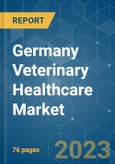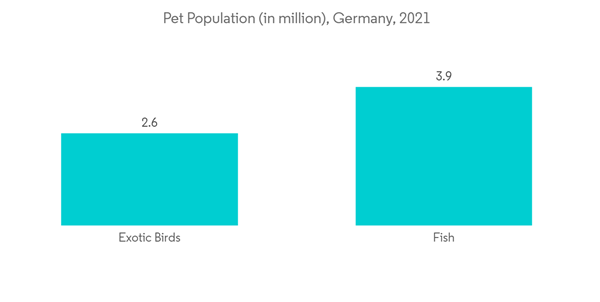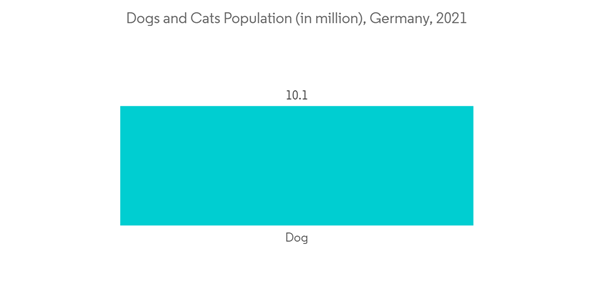The Germany veterinary healthcare market is expected to register a CAGR of 4.5% during the forecast period.
The COVID-19 pandemic impacted the veterinary healthcare market by increasing the costs of animal testing and veterinary care. Supply chain disruptions and shortages of veterinary medicines were observed in several countries, primarily due to the temporary lockdowns of manufacturing sites, export bans, and increased demand for medicine for the treatment of COVID-19. For instance, according to an article published in February 2021, the demand for veterinary services and visits to pet clinics reduced in the country during the COVID-19 pandemic, impacting the growth of the veterinary healthcare market. Furthermore, according to a Health for Animals article, the World Veterinary Association (WVA) and regional veterinary organizations in Europe declared veterinary services to be essential in 2020, just like human healthcare services. As a result, a large number of veterinarians worked under the COVID-19 circumstances. The European Medicines Agency (EMA) created and implemented a few standards to guarantee the accessibility of veterinary medications on the German market. However, with pet clinic services resuming and the relaxation of COVID-19 restrictions, the German veterinary healthcare market is expected to grow over the forecast period.
According to Der Deutsche Heimtiermarkt, 47% of the households in Germany had pets in 2021. In addition, 34.7 million dogs, cats, small animals, and ornamental birds were kept by the population in the country. In Germany, laws and the veterinary administration work together to safeguard animal health. They guarantee good animal husbandry and cleanliness and efficient disease prevention and eradication efforts. It also confirms whether or not animals are given effective, authorized veterinary medicines. Therefore, it is projected that such occurrences will favor market growth in Germany throughout the forecast period.
The strategic initiatives adopted by key market players, such as product approvals, launches, partnerships, and acquisitions, are fueling the market growth. For instance, in July 2021, Boehringer Ingelheim revealed that the 2.0 version of the FreVAX smartphone app could control the FreVAX intramuscular needle-free device. It was developed to improve communication with the FreVAX system, a pig intramuscular needle-free vaccine injection device. Similarly, in November 2021, Felpreva (tigolaner/emodepside/praziquantel), to treat both internal and external parasite infestations for cats, was granted marketing authorization by the European Commission for marketing in Germany.
However, the increasing cost of animal testing and veterinary services is expected to hinder market growth.
Various market players are engaged in strategic initiatives such as product launches, approvals, and partnerships fueling the segment's growth. For instance, in March 2022, Boehringer Ingelheim launched the porcine parvovirus vaccine ReproCyc ParvoFLEX for healthy gilts and sowed six months and older. It offers practical and safe protection against reproductive failure brought on by porcine parvovirus. The innovation in the vaccine segment is estimated to propel the demand and its usage on a large scale to treat deadly diseases and ultimately add to the segment's growth.
Also, in April 2022, the PREVEXXION RN+HVT+IBD and PREVEXXION RN vaccinations for Marek's disease were launched by Boehringer Ingelheim in the EU nations, including the United Kingdom and Germany. As a result, these changes are projected to benefit the market, spurring segment expansion over the projection period.
The growing population and increasing adoption of dogs and cats by the German population is expected to increase the demand for their vaccines and the need for healthcare to prevent them from developing zoonotic diseases, which are anticipated to propel the segment growth during the forecast period. For instance, the European Pet Food Industry report reported 10,300,000 dogs and 16,700,000 cats in Germany in 2021. As per the same source, the estimated percentage of German households owing at least one cat was 21%, and one dog was 19% in 2021. This indicates that the adoption of cats was higher among the population than dogs. Pet adoption is estimated to propel healthcare expenses, boosting segment growth.
Furthermore, according to Der Deutsche Heimtiermarkt, 2022, the number of cats adopted was higher in Germany as compared to dogs, as 16.7 million cats live in 26% of German households compared to 10.3 million dogs in 21% of households. Also, from the same source, the number of mixed-breed dogs has increased from 42% to 44%. Germany is the European nation with the most significant number of cats and dogs as pets.
Thus, the increasing adoption of dogs and cats by the population in the country is expected to increase the demand for their therapeutics and diagnostics, which is anticipated to propel the segment growth over the forecast period.
This product will be delivered within 2 business days.
The COVID-19 pandemic impacted the veterinary healthcare market by increasing the costs of animal testing and veterinary care. Supply chain disruptions and shortages of veterinary medicines were observed in several countries, primarily due to the temporary lockdowns of manufacturing sites, export bans, and increased demand for medicine for the treatment of COVID-19. For instance, according to an article published in February 2021, the demand for veterinary services and visits to pet clinics reduced in the country during the COVID-19 pandemic, impacting the growth of the veterinary healthcare market. Furthermore, according to a Health for Animals article, the World Veterinary Association (WVA) and regional veterinary organizations in Europe declared veterinary services to be essential in 2020, just like human healthcare services. As a result, a large number of veterinarians worked under the COVID-19 circumstances. The European Medicines Agency (EMA) created and implemented a few standards to guarantee the accessibility of veterinary medications on the German market. However, with pet clinic services resuming and the relaxation of COVID-19 restrictions, the German veterinary healthcare market is expected to grow over the forecast period.
According to Der Deutsche Heimtiermarkt, 47% of the households in Germany had pets in 2021. In addition, 34.7 million dogs, cats, small animals, and ornamental birds were kept by the population in the country. In Germany, laws and the veterinary administration work together to safeguard animal health. They guarantee good animal husbandry and cleanliness and efficient disease prevention and eradication efforts. It also confirms whether or not animals are given effective, authorized veterinary medicines. Therefore, it is projected that such occurrences will favor market growth in Germany throughout the forecast period.
The strategic initiatives adopted by key market players, such as product approvals, launches, partnerships, and acquisitions, are fueling the market growth. For instance, in July 2021, Boehringer Ingelheim revealed that the 2.0 version of the FreVAX smartphone app could control the FreVAX intramuscular needle-free device. It was developed to improve communication with the FreVAX system, a pig intramuscular needle-free vaccine injection device. Similarly, in November 2021, Felpreva (tigolaner/emodepside/praziquantel), to treat both internal and external parasite infestations for cats, was granted marketing authorization by the European Commission for marketing in Germany.
However, the increasing cost of animal testing and veterinary services is expected to hinder market growth.
Germany Veterinary Healthcare Market Trends
Vaccine Segment is Expected to Hold a Significant Market Share Over the Forecast Period
Vaccines comprise viruses, bacteria, and other disease-causing organisms that have been killed or altered so that they cannot cause any disease, boosting immunity. New advanced vaccines have been manufactured containing genetically engineered components derived from those disease agents.Various market players are engaged in strategic initiatives such as product launches, approvals, and partnerships fueling the segment's growth. For instance, in March 2022, Boehringer Ingelheim launched the porcine parvovirus vaccine ReproCyc ParvoFLEX for healthy gilts and sowed six months and older. It offers practical and safe protection against reproductive failure brought on by porcine parvovirus. The innovation in the vaccine segment is estimated to propel the demand and its usage on a large scale to treat deadly diseases and ultimately add to the segment's growth.
Also, in April 2022, the PREVEXXION RN+HVT+IBD and PREVEXXION RN vaccinations for Marek's disease were launched by Boehringer Ingelheim in the EU nations, including the United Kingdom and Germany. As a result, these changes are projected to benefit the market, spurring segment expansion over the projection period.
Dogs and Cats are Expected to Hold a Significant Market Share Over The Forecast Period
Dogs and Cats are expected to hold a significant market share owing to the reasons such as rising adoption, rising pet healthcare expenses, and insurance facilities for pets.The growing population and increasing adoption of dogs and cats by the German population is expected to increase the demand for their vaccines and the need for healthcare to prevent them from developing zoonotic diseases, which are anticipated to propel the segment growth during the forecast period. For instance, the European Pet Food Industry report reported 10,300,000 dogs and 16,700,000 cats in Germany in 2021. As per the same source, the estimated percentage of German households owing at least one cat was 21%, and one dog was 19% in 2021. This indicates that the adoption of cats was higher among the population than dogs. Pet adoption is estimated to propel healthcare expenses, boosting segment growth.
Furthermore, according to Der Deutsche Heimtiermarkt, 2022, the number of cats adopted was higher in Germany as compared to dogs, as 16.7 million cats live in 26% of German households compared to 10.3 million dogs in 21% of households. Also, from the same source, the number of mixed-breed dogs has increased from 42% to 44%. Germany is the European nation with the most significant number of cats and dogs as pets.
Thus, the increasing adoption of dogs and cats by the population in the country is expected to increase the demand for their therapeutics and diagnostics, which is anticipated to propel the segment growth over the forecast period.
Germany Veterinary Healthcare Market Competitor Analysis
The Germany veterinary healthcare market is moderately fragmented and consists of several major players. Companies like Boehringer Ingelheim International GmbH, Ceva Animal Health Inc, Elanco Animal Health, Idexx Laboratories, Merck & Co. Inc., Phibro Animal Health, Randox Laboratories, Ltd, Vetoquinol GmbH, Virbac SA, Zoetis, Inc, among others, hold the substantial market share in the Veterinary Healthcare market in Germany.Additional benefits of purchasing the report:
- The market estimate (ME) sheet in Excel format
- 3 months of analyst support
This product will be delivered within 2 business days.
Table of Contents
1 INTRODUCTION
4 MARKET DYNAMICS
5 MARKET SEGMENTATION (Market Size by Value in USD million)
6 COMPETITIVE LANDSCAPE
Companies Mentioned (Partial List)
A selection of companies mentioned in this report includes, but is not limited to:
- Boehringer Ingelheim International GmbH
- Ceva Animal Health
- Elanco Animal Health
- Idexx Laboratories
- Merck & Co. Inc.
- Phibro Animal Health
- Vetoquinol
- Virbac SA
- Zoetis, Inc
Methodology

LOADING...










